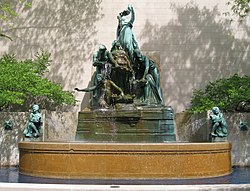Victory Sculpture | |
 View facing north | |
| Location | 35th Street and King Drive Chicago, IL |
|---|---|
| Coordinates | 41°49′50.6″N87°37′1.7″W / 41.830722°N 87.617139°W |
| Built | 1927 |
| Architect | John A. Nyden |
| Sculptor | Leonard Crunelle |
| MPS | Black Metropolis TR |
| NRHP reference No. | 86001089 [1] |
| Significant dates | |
| Added to NRHP | April 30, 1986 |
| Designated CL | September 9, 1998 |
Erected in 1927, the Victory Monument, is a bronze and granite sculptural monument, based on a concept by John A. Nyden, and sculpted by Leonard Crunelle. [2] It was built to honor the Eighth Regiment of the Illinois National Guard, an African-American unit that served with distinction in France during World War I. [1] It may be the only memorial statue dedicated to African-American soldiers of the Great War. [3]
Contents
The memorial monument is located in the Black Metropolis-Bronzeville District in the Douglas community area on the South Side of Chicago, Illinois. The structure was added to the National Register of Historic Places on April 30, 1986. [1] It was designated a Chicago Landmark on September 9, 1998. [4] An annual Memorial Day ceremony is held at the monument. [4]






